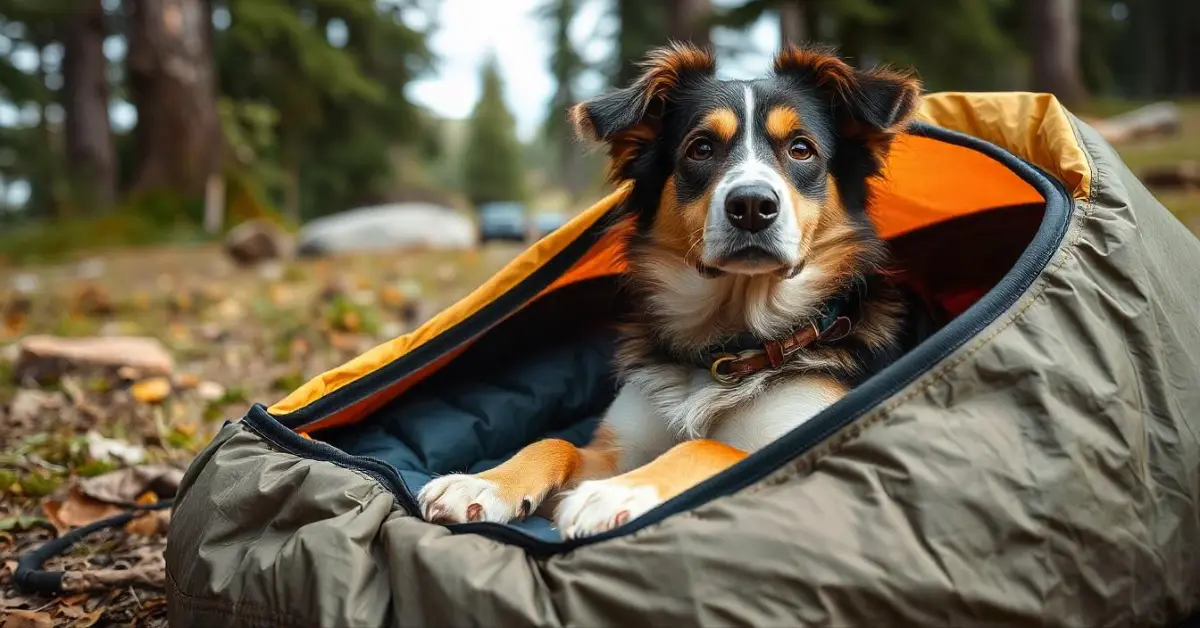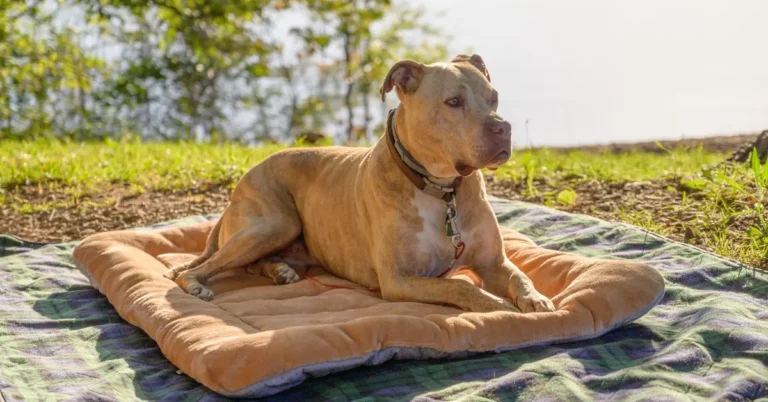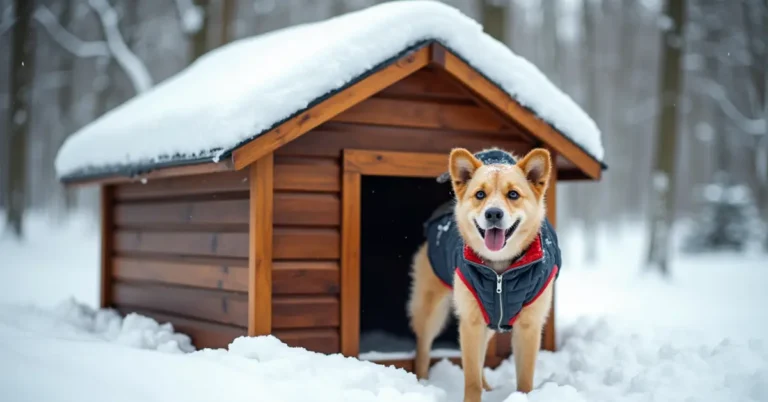There’s nothing quite like sharing the great outdoors with your four-legged companion. But as any seasoned dog owner knows, keeping your furry friend warm and comfortable during overnight camping trips can be challenging. Whether you’re planning a weekend camping trip or embarking on a longer backpacking adventure, having the right sleeping gear for your dog is essential.
In this comprehensive guide, we’ll explore the best dog sleeping bags available in 2025, helping you make an informed decision to keep your canine companion cozy under the stars. We’ve tested and evaluated numerous options to bring you recommendations that suit different needs and budgets.
Table of Contents
Best Dog Sleeping Bags at a Glance
- Best Overall: Ruffwear Highlands Sleeping Bag
- Most Durable: Hurtta Outback Dreamer
- Best Budget Option: Cheerhunting Dog Sleeping Bag
- Warmest Option: Whyld River DoggyBag
- Best for Backpacking: KONG Sleeping Bag
- Most Versatile: Chuckit! Travel Dog Bed
- Best Premium Choice: Nemo x Kurgo Dog Sleeping Bag
- Best for Large Dogs: Ozark Trail Pet Sleeping Bag
- Most Comfortable: K9 Sport Sack Sleeper
In-Depth Dog Sleeping Bag Reviews
Ruffwear Highlands Sleeping Bag – Best Overall
Price: $99.95
✅ Pros:
- Synthetic insulation performs well when wet
- Durable water-repellent finish
- Compresses well for backpacking
- Integrated sleeve for sleeping pad
- Available in multiple sizes
❌ Cons:
- Premium price point
- Heavier than down alternatives
- Limited color options
Key Specs:
- Weight: 1.4 lbs (medium size)
- Fabric: 75D polyester
- Fill: Synthetic insulation
The Ruffwear Highlands Sleeping Bag stands out as our top pick for its exceptional combination of durability, warmth, and practical features. During our testing, this bag proved itself worthy in various conditions, from mild spring nights to chilly autumn evenings. The synthetic insulation maintains its warming properties even when damp, making it ideal for unpredictable weather conditions.
What sets this bag apart is its thoughtful design. The side zipper allows for easy entry and exit, while the integrated pad sleeve prevents sliding during the night. The bag’s oval shape accommodates both curled and sprawled sleeping positions, making it suitable for most dogs’ sleeping habits.
Hurtta Outback Dreamer – Most Durable
Price: $89.99
✅ Pros:
- Extremely tough outer shell
- Heat-reflecting foil layer
- Machine washable
- High-visibility reflective trim
- Weather-resistant exterior
❌ Cons:
- Bulkier when packed
- Limited size options
- Higher weight
Key Specs:
- Weight: 1.8 lbs
- Fabric: 300D polyester
- Fill: Double-layer thermal insulation
The Hurtta Outback Dreamer earns our top spot for durability thanks to its robust construction and thoughtful design. During our field testing, the 300-denier polyester outer shell showed remarkable resistance to wear and tear, even when used on rough terrain. The unique heat-reflecting foil layer adds extra warmth without bulk, making it especially effective in cold conditions.
Cheerhunting Dog Sleeping Bag – Best Budget Option
Price: $29.99
✅ Pros:
- Affordable price point
- Lightweight design
- Easy to clean
- Comes with storage bag
- Water-resistant bottom
❌ Cons:
- Less durable than premium options
- Limited insulation
- Basic features only
Key Specs:
- Weight: 1.2 lbs
- Fabric: 190T polyester
- Fill: Cotton padding
For pet owners on a budget, the Cheerhunting Dog Sleeping Bag offers impressive value. While it may not have all the bells and whistles of premium options, it provides adequate warmth for mild to moderate conditions. The water-resistant bottom helps protect against ground moisture, making it suitable for camping in fair weather.
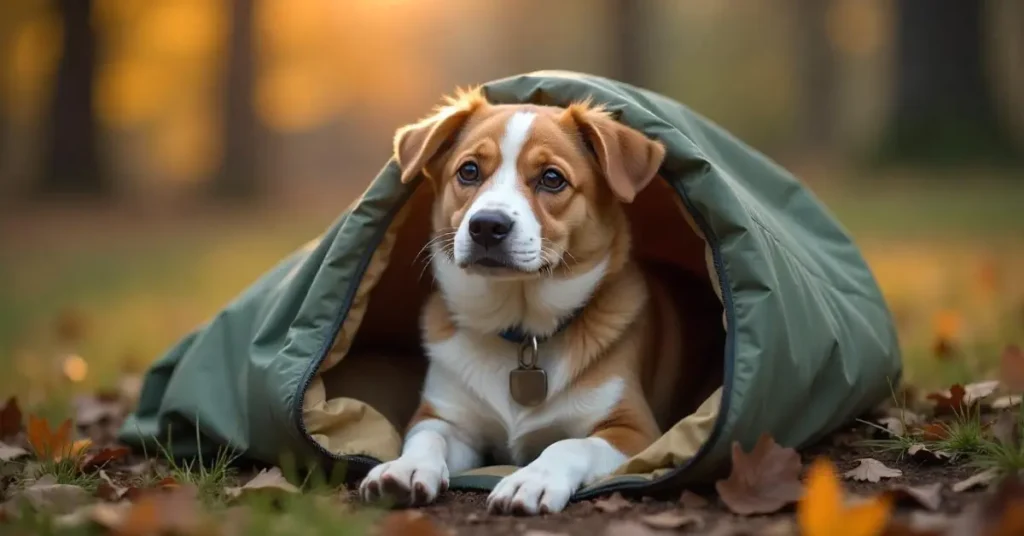
Key Factors to Consider When Choosing a Dog Sleeping Bag
Price Range and Value
Dog sleeping bags typically fall into three price categories:
- Budget ($20-40): These bags offer basic functionality and are suitable for occasional use in mild conditions. They often feature simpler materials and construction, like our budget pick, the Cheerhunting Dog Sleeping Bag.
- Mid-range ($40-80): These bags provide a good balance of durability and features, often including water-resistant coatings and better insulation.
- Premium ($80+): High-end bags like the Ruffwear Highlands and Hurtta Outback Dreamer offer superior materials, advanced features, and better durability for serious outdoor enthusiasts.
Weight and Portability
When choosing a sleeping bag, consider both your dog’s size and your camping style:
- For backpacking: Aim for bags under 2 lbs to minimize pack weight. Down-filled options typically offer the best warmth-to-weight ratio.
- For car camping: Weight becomes less crucial, allowing you to prioritize comfort and durability over portability.
Warmth and Insulation Types
Different insulation materials offer varying benefits:
Down Insulation:
- Highest warmth-to-weight ratio
- Excellent compressibility
- Less effective when wet
- Typically more expensive
Synthetic Insulation:
- Maintains warmth when damp
- More affordable
- Easier to clean
- Heavier than down
For maximum warmth, look for:
- Higher fill power in down bags (600+ is excellent)
- Multiple layers of synthetic insulation
- Heat-reflective layers
- Draft collars or tubes
Temperature Ratings and Performance Comparisons
To help you make a more informed decision, here is a detailed comparison of down and synthetic insulation types, including their performance in various temperature ranges and weather conditions.
Down Insulation
Temperature Ratings:
- Optimal Performance: 20°F to 40°F (-7°C to 4°C)
- Good Performance: 10°F to 50°F (-12°C to 10°C)
- Limited Performance: Below 10°F (-12°C) or above 50°F (10°C)
Weather Conditions:
- Dry Conditions: Excellent warmth-to-weight ratio and compressibility.
- Damp Conditions: Loses significant insulating properties when wet.
- Wind: Can be affected by wind, reducing its insulating efficiency.
Synthetic Insulation
Temperature Ratings:
- Optimal Performance: 0°F to 30°F (-18°C to -1°C)
- Good Performance: -10°F to 40°F (-23°C to 4°C)
- Limited Performance: Below -10°F (-23°C) or above 40°F (4°C)
Weather Conditions:
- Dry Conditions: Good warmth-to-weight ratio, though not as high as down.
- Damp Conditions: Retains insulating properties even when wet.
- Wind: Generally less affected by wind compared to down insulation.
Example Scenarios
Cold and Dry Conditions
- Down Insulation: A down-filled sleeping bag would be ideal for cold, dry nights, providing excellent warmth and light weight.
- Synthetic Insulation: While synthetic insulation works well in cold conditions, it may be heavier and less compressible than down.
Wet and Cold Conditions
- Down Insulation: Avoid using down insulation in wet conditions as it loses its insulating properties.
- Synthetic Insulation: Synthetic insulation is a better choice for wet and cold conditions as it maintains its warmth even when damp.
Mild and Windy Conditions
- Down Insulation: Down insulation can be less effective in windy conditions but still provides good warmth in mild temperatures.
- Synthetic Insulation: Synthetic insulation is more resistant to wind and maintains its insulating properties better in mild and windy conditions.
Performance Chart
| Insulation Type | Optimal Temperature Range | Performance in Wet Conditions | Performance in Windy Conditions |
|---|---|---|---|
| Down | 20°F to 40°F (-7°C to 4°C) | Poor | Fair |
| Synthetic | 0°F to 30°F (-18°C to -1°C) | Good | Good |
This chart and the examples provided should help you choose the right insulation type based on the specific weather conditions you expect to encounter during your outdoor adventures.
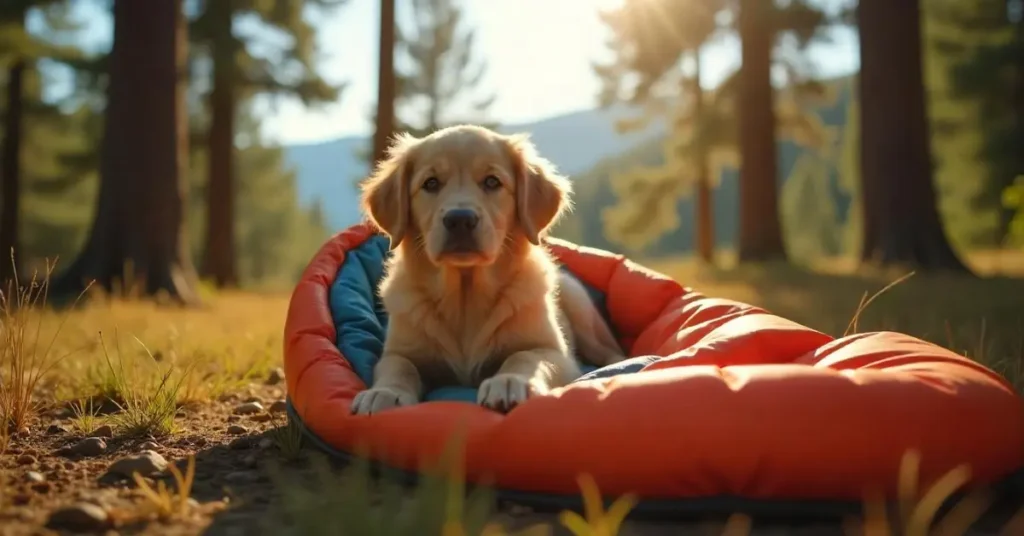
Size and Fit Considerations
Measuring Your Dog Accurately
Proper sizing is crucial for your dog’s comfort and the sleeping bag’s effectiveness. Here are some practical tips to help you measure your dog accurately, even if they are restless:
Using Treats and Rewards
To keep your dog still during the measurement process, use treats or their favorite toys as rewards. This can help distract them and make the process smoother.
Having a Helper
Enlist the help of a friend or family member to hold your dog gently in place while you take the measurements. This can be particularly helpful if your dog is very active or restless.
Measuring While Asleep
If your dog is difficult to measure when awake, try taking the measurements while they are asleep. This is often the best time to get accurate measurements without any fuss.
Step-by-Step Measurement Guide
- Length: Measure from the tip of your dog’s nose to the base of their tail while they are in their typical sleeping position. Add 6-8 inches to this measurement to accommodate movement.
- Width: Measure at the widest point of your dog’s body while they are in their sleeping position. This ensures the sleeping bag is spacious enough for comfort.
- Sleeping Style Adjustments:
- Curled Sleepers: Standard-sized bags usually work well.
- Sprawlers: Consider oversized options or bags with expandable features.
- Multiple Dogs: Size up or consider multiple bags.
By following these tips, you can ensure that you get precise measurements, which will help you select the right size of sleeping bag for your dog, enhancing their comfort and the effectiveness of the sleeping bag.
Durability Features
When evaluating the durability of a dog sleeping bag, it is crucial to focus on several key elements and to know how to assess the gear over time.
Initial Assessment
- Denier (D) Rating of Fabrics: The denier rating plays a significant role in the longevity of the sleeping bag. Higher numbers indicate stronger materials – bags with 75D or higher offer excellent durability for regular outdoor use.
- Reinforced Materials: Premium options like the Hurtta Outback Dreamer use reinforced materials in high-wear areas such as the bottom and entry points.
- Stitching and Seams: Look for reinforced stitching at stress points. High-quality bags often use YKK or similar quality zippers.
- Fabric Construction: Ripstop fabric construction is another indicator of durability.
Visual Indicators of Wear and Tear
To ensure your dog sleeping bag remains in good condition, regularly inspect it for signs of wear and tear:
Seam Inspection
- Check the seams for any signs of fraying or unraveling. If you notice any damage, it is advisable to repair it immediately to prevent further deterioration.
Fabric Thinning
- Inspect the fabric for any thinning or weakening, especially in areas that come into contact with the ground or are subject to heavy use.
Zipper Functionality
- Ensure that zippers are functioning smoothly and not showing signs of wear. Stuck or rusty zippers can be a sign that the bag needs maintenance or replacement.
Fill Power and Insulation
- For bags with down insulation, check the fill power by compressing the bag and then releasing it. If the bag does not loft back up quickly, it may be losing its insulating properties.
- For synthetic insulation, look for any clumping or uneven distribution of the fill material.
Water Resistance
- Test the water-resistant coating by applying a small amount of water to the fabric. If the water no longer beads up and rolls off, it may be time to reapply the DWR coating.

Maintenance Tips
Regular maintenance can extend the life of your dog sleeping bag:
- Clean Promptly: Clean the bag after each use to prevent dirt and debris from accumulating and causing damage.
- Store Uncompressed: Store the bag uncompressed to prevent fabric creasing and damage to the insulation.
- Repair Small Tears: Immediately repair any small tears or holes to prevent them from becoming larger issues.
- Reapply DWR Coating: Reapply the DWR coating as needed to maintain the water-repellent properties of the fabric.
- Air Dry Completely: Before storing the bag, ensure it is completely air-dried to prevent mold and mildew.
By regularly inspecting your dog sleeping bag and performing necessary maintenance, you can ensure it remains in good condition, providing your dog with the comfort and protection needed for safe and enjoyable outdoor adventures.
Waterproofing and Weather Protection
Most dog sleeping bags offer different levels of water protection:
Water-Resistant : Most bags feature a DWR (Durable Water Repellent) coating that repels light moisture. This coating needs periodic reapplication, typically every 15-20 uses or when you notice water no longer beading on the surface.
Reapplying DWR Coatings
To maintain the water resistance of your dog sleeping bag, reapplying the DWR coating is crucial. Here’s a step-by-step guide on how to do it:
Materials Needed
- A DWR coating spray or liquid (e.g., Nikwax Tech Wash and TX.Direct, or Granger’s Performance Repel)
- A clean cloth or sponge
- Mild detergent (if washing the bag before reapplication)
Preparation
- Clean the Bag: Before reapplying the DWR coating, ensure the sleeping bag is clean. If it’s dirty, wash it with mild detergent and let it air dry completely.
- Choose the Right Product: Select a reputable DWR coating product. Nikwax and Granger’s are popular choices known for their effectiveness.
Application Process
- Spray or Apply the DWR Coating: Follow the instructions on the product label. Typically, you spray the DWR coating evenly over the fabric or apply it using a cloth.
- Work it Into the Fabric: Use a clean cloth or sponge to gently work the coating into the fabric, ensuring it’s evenly distributed.
- Allow to Dry: Let the coating dry completely according to the product instructions. This can take anywhere from a few minutes to an hour, depending on the product.
- Inspect and Reapply if Necessary: After the coating has dried, inspect the bag by sprinkling water on it. If the water beads up and rolls off, the coating is effective. If not, you may need to reapply.
Tips for Long-Lasting Water Resistance
- Regular Maintenance: Reapply the DWR coating as recommended by the manufacturer or when you notice a decrease in water repellency.
- Avoid Using Fabric Softeners: Fabric softeners can reduce the effectiveness of DWR coatings.
- Store Properly: Store your dog sleeping bag uncompressed and in a dry place to maintain its water-resistant properties.
Waterproof : Truly waterproof bags incorporate materials like:
- PU (Polyurethane) coated fabrics
- Silnylon (Silicone-impregnated nylon)
- Sealed or taped seams
Remember that even waterproof bags can develop condensation inside, so ventilation remains important.
Comfort and Additional Features
Cooling Features for Warmer Climates
In addition to the warming features, it is crucial to consider cooling mechanisms for dog sleeping bags, especially for warmer climates or summer adventures. Here are some key cooling features to look for:
Breathable Fabrics:
- Look for sleeping bags made from breathable fabrics such as mesh panels, nylon, or polyester that allow for good airflow. These materials help in dissipating heat and keeping your dog cool.
- Fabrics with moisture-wicking properties can also help in managing sweat and keeping the dog dry.
Mesh Panels:
- Mesh panels integrated into the sleeping bag design can significantly enhance ventilation. These panels allow air to circulate, reducing the buildup of heat inside the bag.
- Some bags feature adjustable mesh panels that can be opened or closed depending on the temperature.
Cooling Gel Inserts:
- Some advanced dog sleeping bags include cooling gel inserts that help in regulating the temperature. These inserts absorb heat and release it away from the dog, providing a cooler sleeping environment.
- Cooling gel inserts can be particularly useful for dogs that tend to overheat easily.
Lightweight and Reflective Materials:
- Lightweight materials that reflect sunlight can help in keeping the sleeping bag cooler. Reflective coatings or light-colored fabrics can reduce the absorption of heat from the sun.
- Some bags come with detachable hoods or canopies that provide shade and protect the dog from direct sunlight.
Seasonal Versatility
When choosing a dog sleeping bag, consider its versatility across different seasons. A bag that can be easily converted or adjusted for warmer weather is ideal:
Convertible Designs:
- Some sleeping bags have convertible designs that allow you to remove layers or open up mesh panels to adapt to warmer conditions.
- Look for bags with zip-out liners or removable hoods that can be taken off during warmer nights.
Adjustable Ventilation:
- Adjustable ventilation systems, such as zippers or Velcro openings, can help in regulating the temperature inside the bag. This allows you to customize the airflow based on the weather.
By considering these cooling features, you can ensure your dog remains comfortable not just in cold weather but also in warmer climates, making the dog sleeping bag a versatile and year-round solution.
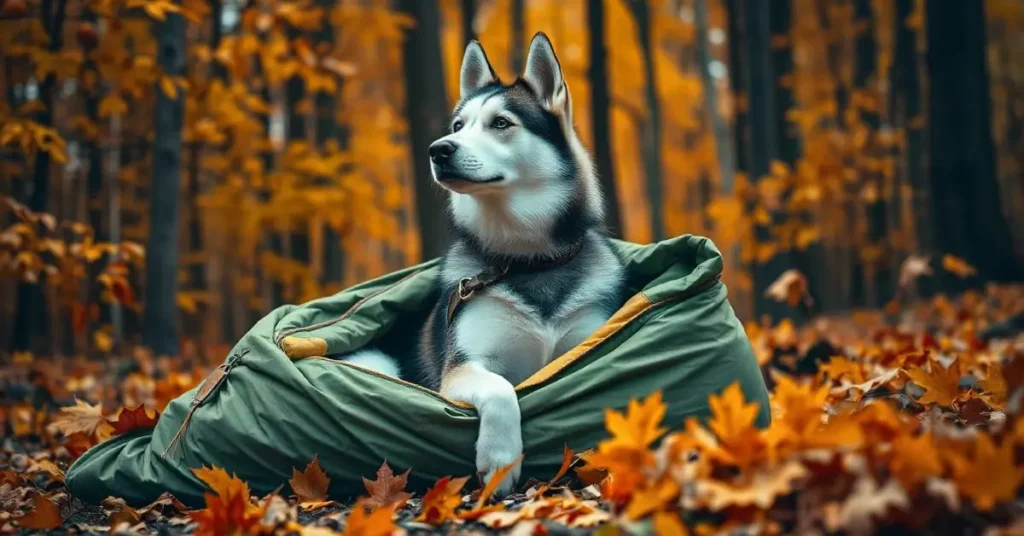
When to Use a Dog Sleeping Bag
Breed-Specific Considerations
In addition to the general temperature guidelines, it’s crucial to consider the specific breed characteristics of your dog when deciding whether to use a sleeping bag.
Cold-Susceptible Breeds
Some breeds are more prone to feeling cold due to their physical characteristics or origins. For example:
- Greyhounds: With their thin coats and lean bodies, Greyhounds can quickly feel the chill, especially in temperatures below 40°F (4°C).
- Chihuahuas: These small dogs have minimal body fat and short coats, making them highly susceptible to cold temperatures. They may need additional warmth even in mild conditions.
- Italian Greyhounds: Similar to Greyhounds, Italian Greyhounds are also sensitive to cold due to their slender build and short coats.
- Chinese Crested: Both the hairless and powderpuff varieties of Chinese Crested dogs can feel cold easily, especially the hairless type which lacks a protective coat.
Cold-Tolerant Breeds
On the other hand, some breeds are naturally more resilient to cold temperatures due to their thick coats, body fat, or origins:
- Huskies: Bred for Arctic environments, Huskies have thick double coats that provide excellent insulation, making them more tolerant of cold temperatures.
- Malamutes: Similar to Huskies, Malamutes are built for cold climates and can handle lower temperatures with ease.
- Newfoundlands: With their thick, water-resistant coats, Newfoundlands are well-suited for colder conditions.
- Bernese Mountain Dogs: Originating from the Swiss Alps, these dogs have thick coats that help them withstand cold temperatures.
Special Considerations
- Short-haired breeds: As mentioned earlier, short-haired breeds need extra warmth sooner. This includes breeds like Boxers, Bulldogs, and Pugs.
- Senior dogs: Older dogs often require additional insulation due to decreased metabolism and potential health issues.
- Puppies under one year: Puppies, especially those under one year, need more temperature protection as they are still developing and may not have the full insulation of their adult coats.
- Working or active dogs: Dogs that are highly active or work in cold conditions may need less insulation due to their higher metabolism, but it’s still important to monitor their comfort levels.
By considering these breed-specific factors, you can tailor your approach to using a dog sleeping bag to better meet the unique needs of your pet.
Sleeping System Options
Shared Sleeping System : Benefits:
- Shared body heat
- Stronger bond with your pet
- Less gear to carry
Challenges:
- Potential gear damage
- Disrupted sleep
- Space limitations
Minimizing Gear Damage in Shared Sleeping Systems
To enjoy the benefits of a shared sleeping system while minimizing the risk of gear damage, consider the following tips:
Use Protective Covers
Invest in protective covers or liners for your sleeping bag and pad. These can prevent scratches and tears caused by your dog’s claws or teeth. Look for durable, waterproof materials that are easy to clean.
Trim Your Dog’s Nails
Before heading out on your camping trip, trim your dog’s nails to reduce the risk of punctures or tears in your gear. Keeping your dog’s nails well-maintained can make a significant difference in preserving your equipment.
Utilize a Durable Groundsheet
A durable groundsheets or tarp can protect your tent floor and sleeping gear from damage. Choose a groundsheets made from heavy-duty, waterproof material that can withstand both weather conditions and your dog’s movements.
Secure Your Gear
Ensure all loose items such as zippers, straps, and pockets are securely fastened to prevent your dog from accidentally damaging them. This includes keeping any small parts or accessories safely stored away.
By implementing these measures, you can enjoy the warmth and companionship of a shared sleeping system while protecting your gear from potential damage. Here are some additional tips for tent sleeping:
- Create a Designated Dog Area: Set aside a specific area within the tent for your dog to sleep, helping to keep the rest of the space undisturbed.
- Use a Ground Pad: Place a ground pad under the sleeping bag to add an extra layer of protection and comfort.
- Keep a Small Towel Handy: Have a small towel ready to wipe down your dog before they enter the tent, reducing the amount of dirt and moisture they bring in.
- Consider a Sleeping Bag Liner: Use a sleeping bag liner for extra cleanliness and to make cleaning easier after the trip.
Separate Sleep System
Separate Sleep System : Advantages:
- Individual comfort control
- Better sleep quality
- Extended gear life
Tips for separate sleeping systems remain the same as previously mentioned, focusing on individual comfort and better sleep quality for both you and your dog.
Alternative Solutions
When a dedicated dog sleeping bag isn’t ideal, there are several alternative solutions you can consider. Here’s a detailed analysis of their benefits and drawbacks to help you make an informed decision.
Blanket Systems
Pros:
- Versatility: Blanket systems can be used in a variety of settings, from camping to home use.
- Cost-Effective: Often less expensive than dedicated sleeping bags, making them a budget-friendly option.
- Easy to Clean: Blankets are generally easier to wash and maintain than sleeping bags.
- Multi-Purpose: Can be used for other purposes, such as picnics or as an extra layer at home.
Cons:
- Less Insulation: Blankets may not provide the same level of insulation as a dedicated sleeping bag, especially in cold conditions.
- Bulkier: Blankets can be bulkier to carry, especially if you are backpacking.
- Ground Protection: May not offer the same level of protection from ground moisture as a sleeping bag with a water-resistant bottom.
Types of Blankets:
- Insulated Camping Blankets: These are designed for outdoor use and often have insulation similar to sleeping bags.
- Down Throws: Lightweight and warm, but less effective when wet.
- Wool Blankets: Natural insulation, breathable, and can retain warmth even when damp.
- Emergency Space Blankets: Lightweight, compact, and designed for emergency situations but not ideal for long-term use.
DIY Solutions
Pros:
- Customization: You can tailor the solution to your dog’s specific needs and preferences.
- Cost-Effective: Utilizing items you may already have can save money.
- Creative Freedom: Allows you to be creative and find unique solutions.
Cons:
- Time and Effort: Requires more time and effort to set up and prepare.
- Limited Durability: DIY solutions may not be as durable as commercial products.
- Variable Quality: The quality of the solution depends on the materials and craftsmanship used.
Types of DIY Solutions:
- Modified Human Sleeping Bag: Converting a human sleeping bag to fit your dog can be a viable option, but ensure it is safe and comfortable.
- Converted Down Blanket: Using a down blanket and attaching it to a sleeping pad or creating a makeshift bag can provide adequate warmth.
- Insulated Pad with Attached Blanket: Combining an insulated sleeping pad with a blanket can offer both comfort and insulation.
Considerations:
Regardless of the alternative solution you choose, it is crucial to ensure your dog has adequate insulation from the ground. This can be achieved by using a ground pad or tarp under the blanket or DIY setup. Additionally, consider the weather conditions and your dog’s specific needs to select the most appropriate alternative solution. top covering chosen.
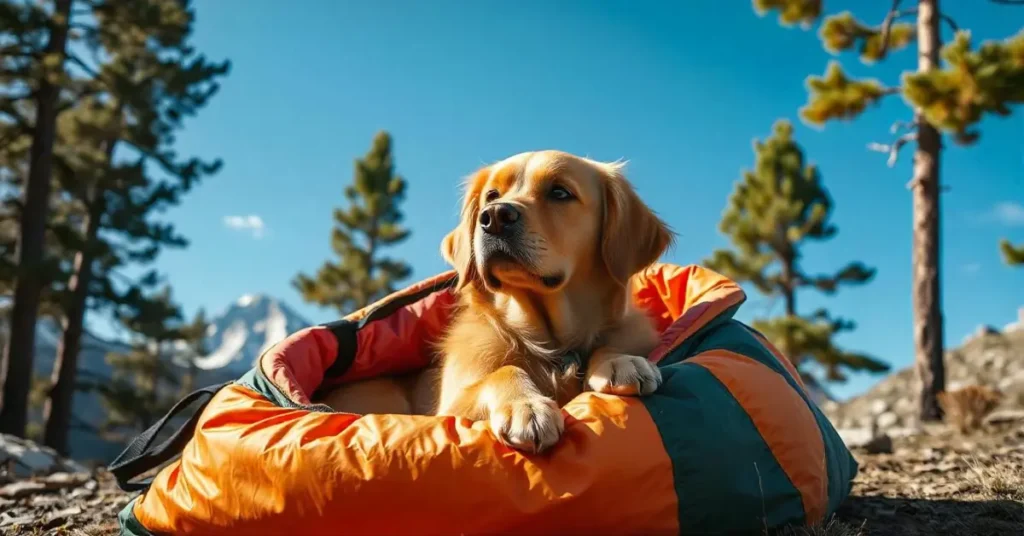
Care and Maintenance
To extend the life of your dog sleeping bag, proper cleaning and maintenance are crucial. Here are detailed guidelines for cleaning both synthetic and down-filled sleeping bags:
Cleaning Synthetic Sleeping Bags
Synthetic sleeping bags are generally easier to clean and maintain than down-filled ones.
Step-by-Step Cleaning Process:
- Check the Label: Before cleaning, always check the manufacturer’s instructions for any specific recommendations.
- Pre-Treat Stains: If there are any stains, pre-treat them with a mild detergent or a stain remover.
- Washing:
- Use a front-loading washing machine or a large capacity top-loading machine without an agitator.
- Choose a mild detergent that is free of bleach and harsh chemicals.
- Set the washing machine to a gentle cycle with cold water (below 30°C or 86°F).
- Rinsing: Ensure thorough rinsing to remove all detergent residue.
- Drying:
- Use a low heat setting on your dryer or air dry the sleeping bag.
- If using a dryer, add a few clean tennis balls to help fluff the insulation.
- Remove the sleeping bag as soon as the cycle is complete to prevent wrinkling.
Cleaning Down-Filled Sleeping Bags
Down-filled sleeping bags require more care to maintain the loft and insulation properties of the down filling.
Step-by-Step Cleaning Process:
- Check the Label: Always follow the manufacturer’s cleaning instructions.
- Pre-Treat Stains: Gently pre-treat any stains with a down-specific cleaner or a mild detergent.
- Washing:
- Use a front-loading washing machine or a large capacity top-loading machine without an agitator.
- Choose a down-specific cleaner or a mild detergent that is free of bleach and harsh chemicals.
- Set the washing machine to a gentle cycle with cold water (below 30°C or 86°F).
- Rinsing: Ensure thorough rinsing to remove all detergent residue.
- Drying:
- Air drying is recommended, but if using a dryer, set it to a low heat setting.
- Add a few clean tennis balls to the dryer to help redistribute the down filling.
- Remove the sleeping bag as soon as the cycle is complete and lay it flat to air dry completely.
Additional Tips:
- Storage: Store your sleeping bag uncompressed in a breathable storage bag to maintain its loft and prevent moisture buildup.
- Repair: Repair any small tears immediately to prevent further damage.
- DWR Coating: Reapply the Durable Water Repellent (DWR) coating as needed to maintain water resistance.
- Air Dry: Before storing, ensure the sleeping bag is completely dry to prevent mold and mildew.
By following these cleaning and maintenance guidelines, you can ensure your dog sleeping bag remains in good condition, providing your pet with continued comfort and warmth on your outdoor adventures.
Final Thoughts
Choosing the right dog sleeping bag involves balancing multiple factors, including your camping style, dog’s needs, and environmental conditions. While premium options offer superior features and durability, even budget-friendly choices can provide adequate protection for occasional use in mild conditions.
For tips on choosing comfortable options, check out our must-know tips for dog beds. If you’re considering elevated options, explore why an elevated dog bed is a game changer.
Remember that a dog sleeping bag is an investment in both your pet’s comfort and your shared outdoor adventures. Taking time to select the right option and properly maintain it will ensure many comfortable nights under the stars with your four-legged companion.

